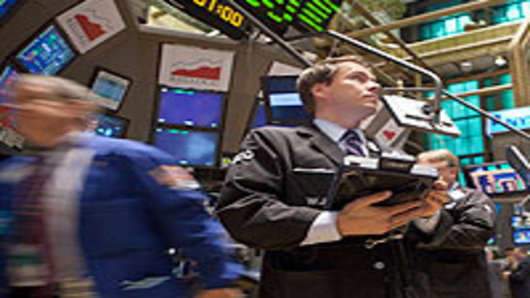Now that stocks and the dollar are moving in tandem again, it could be a signal for investors to put more money into US assets.
For much of the 2009 rally off the March lows the two entities had been in reverse lockstep. When the dollar would fall, stocks would rise and vice versa.
That's because investors were using a currency that cost almost nothing to borrow to buy undervalued stocks, with a bias toward multinational and emerging markets.
While it isn't much of a recipe for a strong economy, the combination helped lift stocks off their lows after the financial collapse and gave investors room to breathe as the economy recovered from its worst state since the Great Depression.
But with some upward trends in the economy and the likelihood that the Federal Reserve in the coming months will begin implementing policies to boost the dollar, the two have risen together this year.
Analysts see the trend as less a dollar play and more a recovery move, and as a return to normal after the inverse correlation between the stocks and US currency.
"The currency is doing well. That usually means the economy's doing well and your stock market should do OK," says Ryan Detrick, analyst at Schaeffer's Investment Research in Cincinnati. "Things are coming back more to normalcy."
For investors, that means more money is likely to come back to US-centric companies after a long and strong run for emerging and developed markets abroad.
"You've got an attractive and constructive backdrop for US equities right now," says Quincy Krosby, general strategist at Prudential Financial in Newark, N.J. "What we're seeing is money is shifting into US equities. It isn't as if investors are writing off emerging markets, it's just that emerging markets are quite frothy in valuation. Investors are just basically tilting their portfolios back to US equities."
To be sure, the US economy still faces major obstacles and the correlation between the two asset classes doesn't give an all-clear signs by any means—the trend means that stocks and the dollar will fall together as well.
"Everything fell together in 2008 and now they're rising together in 2010," says Adam Mesh, CEO of Mesh Trading Group in New York. "It's not necessarily how things are supposed to be."
But the trends have been clear.
As the Standard & Poor's 500 has risen about 2 percent in 2010 the dollar index is up nearly 3 percent. Treasury yields, which move opposite to their prices, are off more than 6 percent, indicating a stronger demand for safe-haven debt even as the stock risk trade gains.
In the commodity space, oil has climbed over $80 a barrel and gold has gained about 1.5 percent.
Krosby says the trend in part represents the unwinding of last year's vaunted dollar carry trade, in which the greenback replaced the yen as the world's favorite currency to borrow and use to buy higher-yielding currencies. She also said small- and mid-cap companies should be attractive now that merger and acquisition activity is accelerating after a dead 2009.
"Signs are beginning to point to the yen becoming the main vehicle for the carry trade while the dollar isn't as active," she says. "'The dollar can gain strength on the back of fundamentals and the US equity market can pick up strength on a stock-by-stock and sector-by-sector basis."
The trend also has has been reflected by a drop in the Chicago Board Options Exchange Volatility Index, often seen as the best indicator of market fear. The VIX has fallen below 18, nearing its 2010 low, as investors grow more apathetic about the market.
"Simply put, everything is moving in the same direction lately—to the upside, albeit in a slow and plodding way," Nicholas Colas, president of New York institutional investor advisory firm ConvergEx, wrote in an analysis. "Until there is an exogenous shock or central banks move to reduce global monetary stimulus, higher correlations and lower volatility will likely be the order of the day."
In classic portfolio theory, a sharply correlated market presents dangers to investors in that it reduces the ability to find a strong asset class to use as a hedge.
But Krosby says investors can use a variety of hedges, including annuities and puts that give investors the ability to buy stocks at lower prices in the future.
Detrick says put trading has accelerated, while investors also can short indexed exchange-traded funds, such as the SPDR S&P Trust , for downside protection.
Indeed, Colas said investors need to prepare for a change in the markets, which he said is always just one big event away.
"(T)his cannot be the end of volatility...," he said. "It will return, either from an outside shock or because the world's central banks begin to reduce the stimulus they introduced over the past two years. But it will return."



